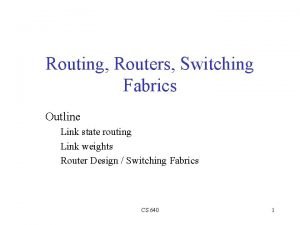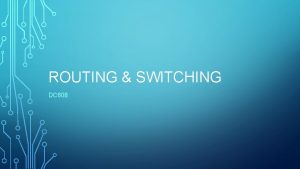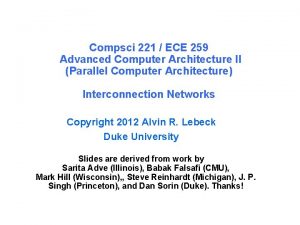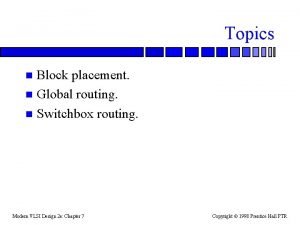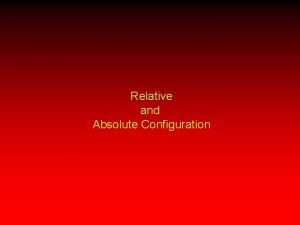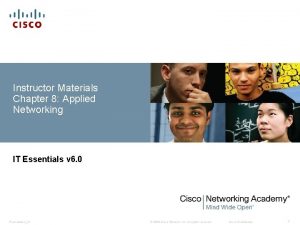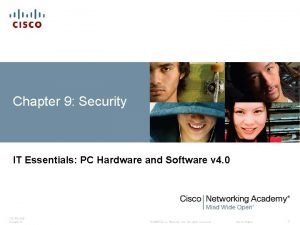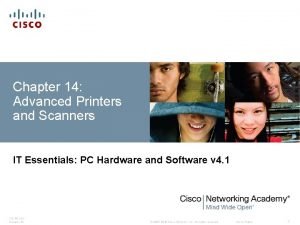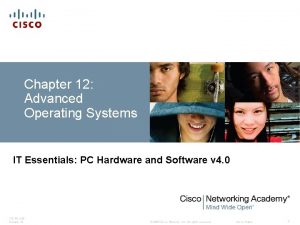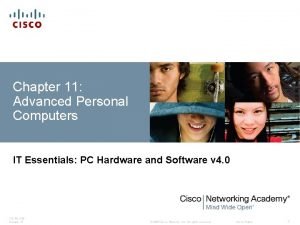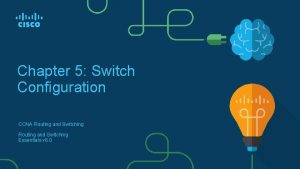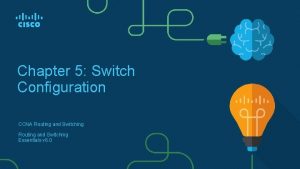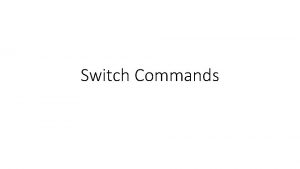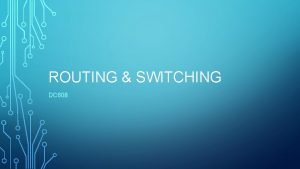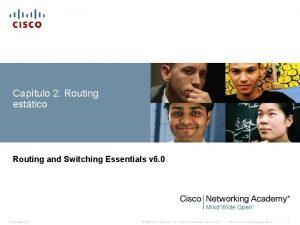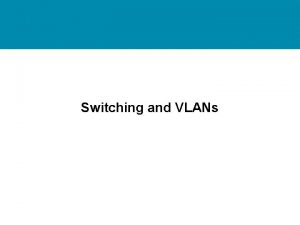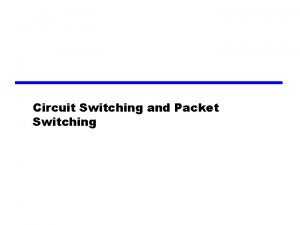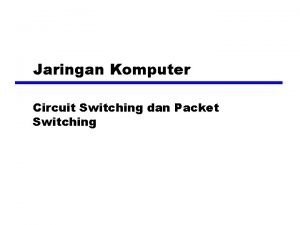Chapter 5 Switch Configuration Routing and Switching Essentials

































- Slides: 33

Chapter 5: Switch Configuration Routing and Switching Essentials v 6. 0 Presentation_ID © 2008 Cisco Systems, Inc. All rights reserved. Cisco Confidential 1

Chapter 5 - Sections & Objectives 5. 1 Basic Switch Configuration • Configure initial settings on a Cisco switch. • Configure switch ports to meet network requirements. 5. 2 Switch Security: Management and Implementation Presentation_ID • Configure the management virtual interface on a switch. • Configure the port security feature to restrict network access. © 2008 Cisco Systems, Inc. All rights reserved. Cisco Confidential 2

5. 1 Basic Switch Configuration Presentation_ID © 2008 Cisco Systems, Inc. All rights reserved. Cisco Confidential 3

Configure a Switch with Initial Settings Switch Boot Sequence 1. Power-on self test (POST). 2. Run boot loader software. 3. Boot loader performs low-level CPU initialization. 4. Boot loader initializes the flash file system. 5. Boot loader locates and loads a default IOS operating system software image into memory and passes control of the switch over to the IOS. Presentation_ID © 2008 Cisco Systems, Inc. All rights reserved. Cisco Confidential 4

Configure a Switch with Initial Settings Switch Boot Sequence (cont. ) To find a suitable Cisco IOS image, the switch goes through the following steps: Step 1. It attempts to automatically boot by using information in the BOOT environment variable. Step 2. If this variable is not set, the switch performs a top-to-bottom search through the flash file system. It loads and executes the first executable file, if it can. Step 3. The IOS software then initializes the interfaces using the Cisco IOS commands found in the configuration file and startup configuration, which is stored in NVRAM. Note: The boot system command can be used to set the BOOT environment variable. Use the show boot command to see to what the current IOS boot file is set. Presentation_ID © 2008 Cisco Systems, Inc. All rights reserved. Cisco Confidential 5

Configure a Switch with Initial Settings Recovering From a System Crash § The boot loader can also be used to manage the switch if the IOS cannot be loaded. § The boot loader can be accessed through a console connection by: 1. Connecting a PC by console cable to the switch console port. Unplug the switch power cord. 2. Reconnecting the power cord to the switch and press and hold the Mode button. 3. The System LED turns briefly amber and then solid green. Release the Mode button. § The boot loader switch: prompt appears in the terminal emulation software on the PC. Presentation_ID © 2008 Cisco Systems, Inc. All rights reserved. Cisco Confidential 6

Configure a Switch with Initial Settings Switch LED Indicators § Each port on Cisco Catalyst switches have status LED indicator lights. § By default, these LED lights reflect port activity, but they can also provide other information about the switch through the Mode button. § The following modes are available on Cisco Catalyst 2960 switches: • System LED • Redundant Power System (RPS) LED • Port Status LED • Port Duplex LED • Port Speed LED • Power over Ethernet (Po. E) Mode LED Presentation_ID © 2008 Cisco Systems, Inc. All rights reserved. Cisco Confidential 7

Configure a Switch with Initial Settings Preparing for Basic Switch Management To remotely manage a Cisco switch, it must be configured to access the network. § A console cable is used to connect a PC to the console port of a switch for configuration. § The IP information (address, subnet mask, gateway) is to be assigned to a switch virtual interface (SVI). § If managing the switch from a remote network, a default gateway must also be configured. § Although these IP settings allow remote management and remote access to the switch, they do not allow the switch to route Layer 3 packets. Presentation_ID © 2008 Cisco Systems, Inc. All rights reserved. Cisco Confidential 8

Configure a Switch with Initial Settings Configuring Switch Management Access Presentation_ID © 2008 Cisco Systems, Inc. All rights reserved. Cisco Confidential 9

Configure a Switch with Initial Settings Configuring Switch Management Access (cont. ) Presentation_ID © 2008 Cisco Systems, Inc. All rights reserved. Cisco Confidential 10

Configure a Switch with Initial Settings Configuring Switch Management Access (cont. ) Presentation_ID © 2008 Cisco Systems, Inc. All rights reserved. Cisco Confidential 11

Configure Switch Ports Duplex Communication Presentation_ID © 2008 Cisco Systems, Inc. All rights reserved. Cisco Confidential 12

Configure Switch Ports at the Physical Layer Presentation_ID © 2008 Cisco Systems, Inc. All rights reserved. Cisco Confidential 13

Configure Switch Ports Auto-MDIX (cont. ) Presentation_ID © 2008 Cisco Systems, Inc. All rights reserved. Cisco Confidential 14

Configure Switch Ports Auto-MDIX (cont. ) Presentation_ID © 2008 Cisco Systems, Inc. All rights reserved. Cisco Confidential 15

Configure Switch Ports Verifying Switch Port Configuration Presentation_ID © 2008 Cisco Systems, Inc. All rights reserved. Cisco Confidential 16

Configure Switch Ports Network Access Layer Issue Presentation_ID © 2008 Cisco Systems, Inc. All rights reserved. Cisco Confidential 17

Configure Switch Ports Network Access Layer Issue (cont. ) Presentation_ID © 2008 Cisco Systems, Inc. All rights reserved. Cisco Confidential 18

Configure Switch Ports Troubleshooting Network Access Layer Issues Presentation_ID © 2008 Cisco Systems, Inc. All rights reserved. Cisco Confidential 19

5. 2 Switch Security: Management and Implementation Presentation_ID © 2008 Cisco Systems, Inc. All rights reserved. Cisco Confidential 20

Secure Remote Access SSH Operation § Secure Shell (SSH) is a protocol that provides a secure (encrypted), command-line based connection to a remote device. § Because of strong encryption features, SSH should replace Telnet for management connections. § SSH uses TCP port 22, by default. § Telnet uses TCP port 23. § A version of the IOS software, including cryptographic (encrypted) features and capabilities, is required to enable SSH on Catalyst 2960 switches. Presentation_ID © 2008 Cisco Systems, Inc. All rights reserved. Cisco Confidential 21

Secure Remote Access Configuring SSH 1. Verify SHH Support – show ip ssh 2. Configure the IP domain. 3. Generate RSA key pairs. 4. Configure user authentication. 5. Configure the vty lines. 6. Enable SSH version 2. Presentation_ID © 2008 Cisco Systems, Inc. All rights reserved. Cisco Confidential 22

Secure Remote Access Verifying SSH Presentation_ID © 2008 Cisco Systems, Inc. All rights reserved. Cisco Confidential 23

Secure Remote Access Verifying SSH (cont. ) Presentation_ID © 2008 Cisco Systems, Inc. All rights reserved. Cisco Confidential 24

Switch Port Security Secure Unused Ports Presentation_ID © 2008 Cisco Systems, Inc. All rights reserved. Cisco Confidential 25

Switch Port Security: Operation § The MAC addresses of legitimate devices are allowed access, while other MAC addresses are denied. § Any additional attempts to connect by unknown MAC addresses generate a security violation. § Secure MAC addresses can be configured in a number of ways: § Static secure MAC addresses – manually configured and added to running configuration - switchport-security macaddress mac-address § Dynamic secure MAC addresses – removed when switch restarts § Sticky secure MAC addresses – added to running configuration and learned dynamically - switchport-security mac -address sticky interface configuration mode command Presentation_ID © 2008 Cisco Systems, Inc. All rights reserved. Cisco Confidential 26

Switch Port Security: Violation Modes § IOS considers a security violation when: § The maximum number of secure MAC addresses for that interface have been added to the CAM, and a station whose MAC address is not in the address table attempts to access the interface. § There are three possible actions to take when a violation is detected: § Protect – no notification received § Restrict – notification received of security violation § Shutdown § switchport-security violation {protect | restrict |shutdown} interface configuration mode command Presentation_ID © 2008 Cisco Systems, Inc. All rights reserved. Cisco Confidential 27

Switch Port Security: Violation Modes (cont. ) Presentation_ID © 2008 Cisco Systems, Inc. All rights reserved. Cisco Confidential 28

Switch Port Security: Configuring Presentation_ID © 2008 Cisco Systems, Inc. All rights reserved. Cisco Confidential 29

Switch Port Security: Verifying Presentation_ID © 2008 Cisco Systems, Inc. All rights reserved. Cisco Confidential 30

Switch Port Security: Verifying (cont. ) Presentation_ID © 2008 Cisco Systems, Inc. All rights reserved. Cisco Confidential 31

Switch Port Security Ports in Error Disabled State § A port security violation can put a switch in error disabled state. § A port in error disabled is effectively shutdown. § The switch communicates these events through console messages. Presentation_ID © 2008 Cisco Systems, Inc. All rights reserved. Cisco Confidential 32

Switch Port Security Ports in Error Disabled State (cont. ) The show interface command also reveals a switch port on error disabled state. A shutdown or no shutdown interface configuration mode command must be issued to reenable the port. Presentation_ID © 2008 Cisco Systems, Inc. All rights reserved. Cisco Confidential 33
 Message switching and packet switching
Message switching and packet switching Datagram switching vs virtual circuit switching
Datagram switching vs virtual circuit switching Advantage and disadvantages of packet switching
Advantage and disadvantages of packet switching Routing and switching protocols
Routing and switching protocols Abderazek ben abdallah
Abderazek ben abdallah 325181028 routing
325181028 routing Inter vlan routing layer 3 switch
Inter vlan routing layer 3 switch Cell switching vs packet switching
Cell switching vs packet switching Each packet is treated independently
Each packet is treated independently Cell switching vs packet switching
Cell switching vs packet switching Reservoir routing example
Reservoir routing example Mark tinka
Mark tinka Continuity equation hydrology
Continuity equation hydrology Clock routing
Clock routing Routing switching adalah
Routing switching adalah Routing switch
Routing switch Block placement meaning
Block placement meaning A switch combines crossbar switches in several stages
A switch combines crossbar switches in several stages Go switch 70 series
Go switch 70 series Absolute vs relative configuration
Absolute vs relative configuration Relative configuration
Relative configuration Electron configuration vs noble gas configuration
Electron configuration vs noble gas configuration Relative configuration
Relative configuration It essential chapter 8
It essential chapter 8 What are the essentials of a successful ffa chapter
What are the essentials of a successful ffa chapter It essential chapter 9
It essential chapter 9 Ite chapter 14
Ite chapter 14 It essential chapter 12
It essential chapter 12 Chapter 11 quiz it essentials
Chapter 11 quiz it essentials Business essentials 12th edition chapter 1
Business essentials 12th edition chapter 1 Marketing essentials chapter 38
Marketing essentials chapter 38 Chapter 13 initiating the sale answer key
Chapter 13 initiating the sale answer key What are the economic utilities that relate to marketing?
What are the economic utilities that relate to marketing? It essential chapter 5
It essential chapter 5



